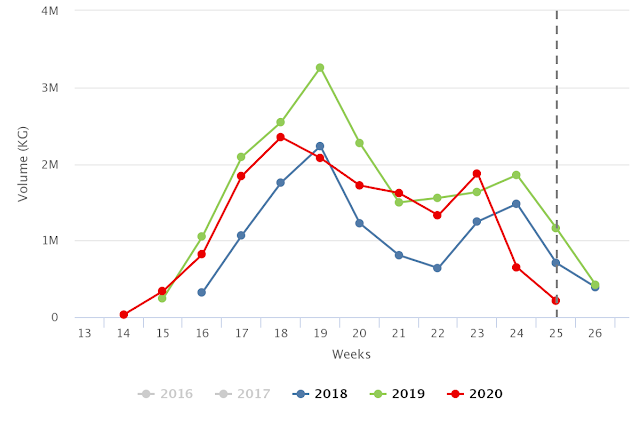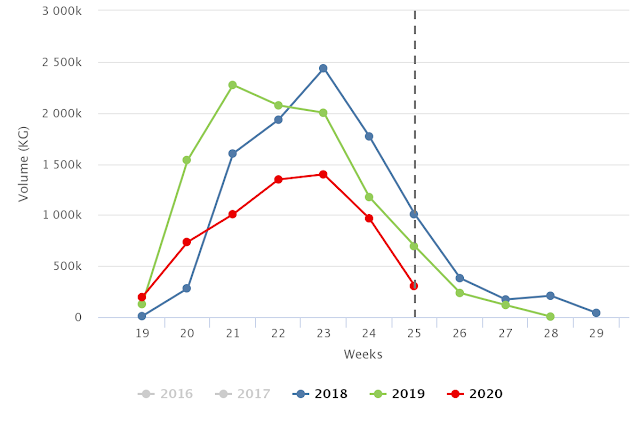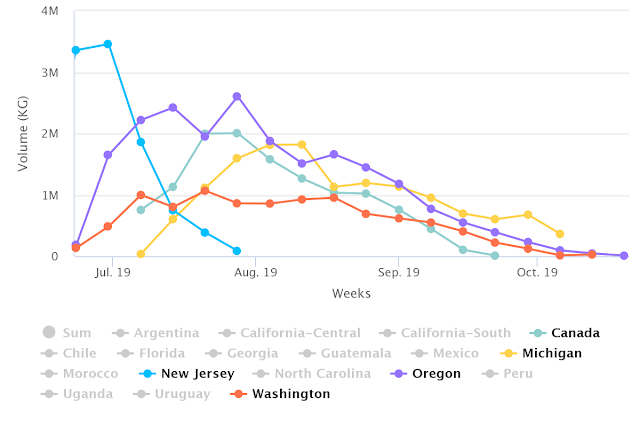Blueberry consumption needs to increase at a higher rate

Overview of the blueberry season by Ryan Lockman of North Bay Produce, complemented by charts from Agronometrics. Original published on June 23, 2020.
It has been a challenging year for the domestic blueberry market. “The growing conditions in many of our regions were devastating,” says Ryan Lockman, VP of Sales and Procurement at North Bay Produce. “Early freezes, heavy rains, winds, hail, hurricanes, and viruses sum up the conditions in both Georgia and North Carolina. We are looking forward to a better situation in our Northern regions and summer crops.”

Source: USDA Market News via Agronometrics.
(Agronometrics users can view this chart with live updates here)

Source: USDA Market News via Agronometrics.
(Agronometrics users can view this chart with live updates here)
Although North Bay is headquartered in Michigan – the country’s third largest blueberry state – blueberries are provided from many different regions throughout the year. These include Florida, Georgia, North Carolina, New Jersey, Michigan, Mississippi, California, Oregon, and Washington. Outside the United States, North Bay works with growers in British Columbia, Uruguay, Argentina, Chile, Peru, Colombia, and Mexico. Out of all these regions, the largest blueberry programs are in Michigan and Chile. “However, Peru, Mexico and Florida are knocking on the door,” according to Lockman.
North American grown blueberries are harvested between March 1 and October 15. “Georgia, North Carolina, Mexico and California are done for the season and right now, harvest is concentrated in New Jersey. Soon, Michigan, Oregon, Washington, and British Columbia will start. Conditions look to be very good in these regions and we are expecting full, quality crops.” Due to COVID-19, labor has been of much concern, but Lockman says it has been plentiful in all regions thus far and expects it to be adequate throughout the summer, barring any political changes.

Source: USDA Market News via Agronometrics.
(Agronometrics users can view this chart with live updates here)
Improve eating experience
Although blueberry consumption is showing an upward trend, supplies are currently growing faster. “As of today, our supply base is growing faster than consumption,” shared Lockman. “In other words, we need consumption to increase at a higher rate to keep supply & demand in balance and keep growers sustainable and profitable. As an industry we are responsible for increasing intake by growing new varieties that provide a better eating experience. We need to entice our customers to come back for repeat purchases and share their good experiences with others. Furthermore, consumption needs to be addressed from a yearly standpoint rather than seasonal.”
North Bay Produce is in a growth mode when it comes to blueberry supplies. “We are growing within our current grower base as well as working with new growers and growing regions, including Washington State and Colombia.”
Exports
Blueberries are marketed in North America, but also exported to Japan, Vietnam, South Korea, Singapore, and Malaysia. “Hopefully, China will be included in this list soon.” Export supply chains are being impacted by COVID-19. “We are dealing with a lack of air freight options, air freight costs being higher than normal, a change in consumer behavior in the countries of destination, and general supply chain issues in getting the fruit from the US to other areas of the world.” As the world economy gets moving, Lockman is hopeful the export supply chain gets back on track and will allow for economical and efficient sales and shipments.
The News in Charts is a collection of stories from the industry complemented by charts from Agronometrics to help better tell their story.
Access the original article with this (Link)






